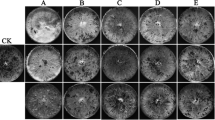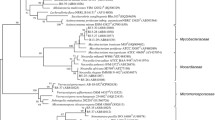Abstract
Macrophomina phaseoli, the cause of root rot of cotton, was inhibited byStreptomyces albus, S. griseus andS. noursei in agar culture.S. aureofaciens, S. flaveolus, S. rimosus, S. scabies andS. venezuelae were non-antagonistic. Only the antagonisticStreptomyces were found to reduceMacrophomina infection on cotton seedlings in soil without any deleterious effect on cotton growth.
Similar content being viewed by others
References
Cooper, W. E. &Chilton, S. J. P. (1950) Studies on antibiotic soil organisms. I. Actinomycetes antibiotic toPythium arrhenomanes in sugarcane soils of Louisiana.Phytopathology, 40:544–5522.
Furushiro, K., Shimizu, K., Sakai, H., Minogata, M. &Fujisawa, T. (1960) Hygrostatin, a new antibiotic substance.Chem. Abstr. 54:10.
Garrett, S. D. (1958) Inoculum potential as a factor limiting lethal action byTrichoderma viride Fr. onArmillaria mellea (Fr.)Quel.Trans. Brit. Mycol. Soc. 41:157–164.
Ghaffar, A. (1968) Interactions of soil fungi withMacrophomina phaseoli (Maubl.)Ashby, the cause of root rot of cotton.Mycopath. et Mycol. Appl. 34:196–201.
Ghaffar, A., Zentmyer, G. A. &Erwin, D. C. (1969) Effect of organic amendments on severity ofMacrophomina root rot of cotton.Phytopathology, 59:1267–1269.
Gregory, K. E., Allen, O. N., Riker, A. J. &Peterson, W. H. (1952) Antibiotics and antagonistic micro-organisms as control agents against damping off of alfalfa.Phytopathology, 42:613–622.
Gregory, K. E., Allen, O. N., Riker, A. J. &Peterson, W. H. (1952) Antibiotics as agents for the control of certain damping off fungi.Amer. J. Bot. 39:405–415.
Keen, B. A. &Raczkowski, H. (1921) The relation between the clay content and certain physical properties of a soil.J. Agric. Sci. 11:441–449.
Nakazawa, K., Oki, K., Tadokoro, I., Honjo, M., Hitomi, H. &Ueyangagi, J. (1954) Studies on streptomycetes. Hygroscopin, an antibiotic substance against fungi and phytopathogens.J. Agric. Chem. Soc. Japan 28:715–716.
Orsenigo, M., Orsenigo, Leda B. &Zucca Rita (1955) Antagonistic action ofActinomyces griseus UC 531 on various fungi.Ann. Fac. Agri. Ser. 2:106–119.
Stessel, G. J., Leben Curt &Keitt, G. W. (1953) Screening tests designed to discover antibiotics suitable for plant disease control.Mycologia, 45:325–334.
Thirumalachar, M. J. (1955) Chainia, a new genus of the Actinomycetales.Nature, Lond. 176:934–935.
Waksman, S. A. (1927) Principles of soil microbiology. London: Bailliere Tyndall & Co.
Waksman, S. A. (1961) The Actinomycetes. Vol. II. Baltimore: The Williams & Wilkins Co.
Author information
Authors and Affiliations
Rights and permissions
About this article
Cite this article
Ghaffar, A. Interactions of actinomycetes with Macrophomina phaseoli (Maubl.) Ashby; The cause of root rot of cotton. Mycopathologia et Mycologia Applicata 44, 271–276 (1971). https://doi.org/10.1007/BF02128641
Accepted:
Issue Date:
DOI: https://doi.org/10.1007/BF02128641




